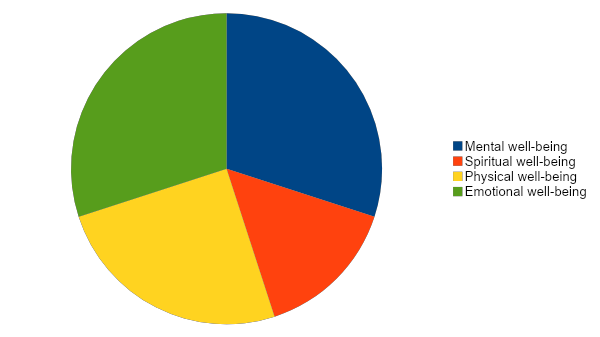Introduction
Stress is a fundamental aspect of human existence and is commonly viewed as a reaction to outside influences. Stress is characterized as the body’s physical and mental response to circumstances. Those can create a challenge or risk to a person’s overall well-being. It is worth noting that certain stress levels are essential for human survival and productivity. It can include the mental stage as well as physical well-being. This essay explores the concept of stress, its measurement, and the importance of adopting a holistic wellness approach to manage stress. A mandala will illustrate the significance of addressing all components of well-being in achieving balance and managing stress.
A Holistic Wellness Approach to Manage Stress

The distribution in Figure 1 places more weight on mental and emotional well-being. A mandala can be utilized as a visual illustration to highlight the significance of mental well-being (Seaward, 2020). The reason behind this is that these components are closely related to how individuals perceive and cope with stress. Physical well-being holds significant importance, as it plays a role in sustaining comprehensive health. Furthermore, it makes the body’s ability to effectively manage stress. While still necessary, spiritual well-being may be considered a supplementary aspect that provides additional support in managing stress through practices like meditation and prayer.
Mental well-being is a balanced mental state that is essential to effectively cope with stress, enabling individuals to perceive and analyze situations accurately and objectively. Moreover, mental well-being contributes to resilience and adaptability (Fusar-Poli et al., 2020). The practice allows individuals to manage stress better. Spiritual well-being relies on having a sense of direction with something greater than oneself. As a crucial element of comprehensive well-being, it offers people inner fortitude and a feeling of connection (Rahmat et al., 2022). It can help them deal with stressful situations. Spiritual practices, such as meditation, prayer, or time in nature, can significantly reduce stress.
The general health of the human body is enclosed via its physical well-being. Through regular exercise, maintaining physical well-being is crucial in managing stress (Jabbar et al., 2021). Its expansion covers having a balanced diet and an adequate sleeping schedule. Physical activity stimulates the release of endorphins and natural mood elevators, while proper nutrition and sleep help maintain the body’s energy levels and immune system. Emotional well-being or emotional wellness involves recognizing, expressing, and regulating emotions. This well-being area is closely related to stress management, as understanding and addressing one’s emotions can help alleviate stress (Frost et al., 2022). Developing healthy emotional coping mechanisms, such as seeking social support or engaging in hobbies, can effectively contribute to stress reduction.
A balanced wellness paradigm is essential when dealing with the stress process. Each area of the holistic wellness model plays a vital role in managing stress levels, as they are interconnected and influence one another. The balance achievement enables people to cope effectively with stressors and maintain a high quality of life. Identifying and creating environments that foster balance in the wellness paradigm is crucial for stress management. For example, I find balance in a workplace that encourages open communication, prioritizes employee well-being, and provides opportunities for personal growth. Communication allows for sharing thoughts, leading to my voice being heard. Prioritization of workers’ health illustrates that the organization cares about them. Finally, personal growth opens the doors to fully demonstrate my abilities. Such an environment promotes all four components that create a balanced life for a human.
Conclusion
In conclusion, stress, an inevitable aspect of human life, can be better managed by adopting a holistic wellness approach. A mandala can be employed as a visual representation to emphasize the importance of mental well-being and bring in other components necessary for balance. By understanding and addressing the needs of all four areas, individuals can achieve a more balanced wellness paradigm and effectively cope with stress. Creating environments that support this balance further enhances one’s ability to manage stress and maintain a high quality of life. In conclusion, adopting a holistic wellness approach and fostering supportive environments can significantly improve stress management and overall well-being.
References
Frost, S., Kannis-Dymand, L., Schaffer, V., Millear, P., Allen, A. E., Stallman, H. M., Mason, J. S., Wood, A. R., & Atkinson-Nolte, J. (2022). Virtual immersion in nature and psychological well-being: a systematic literature review. Journal of Environmental Psychology, 80, 101765. Web.
Fusar-Poli, P., De Pablo, G. S., De Micheli, A., Nieman, D. H., Correll, C. U., Kessing, L. V., Pfennig, A., Bechdolf, A., Borgwardt, S., Arango, C., & Van Amelsvoort, T. (2020). What is good mental health? A scoping review. European Neuropsychopharmacology, 31, 33–46. Web.
Jabbar, M., Yusoff, M. M., & Shafie, A. (2021). Assessing the role of urban green spaces for human well-being: a systematic review. GeoJournal, 87(5), 4405–4423. Web.
Rahmat, H. K., Basri, A. S. H., Putra, R. E., Mulkiyan, M., Wahyuni, S., & Casmini, C. (2022). The influenced factors of spiritual well-being: a systematic review. Sociocouns: Journal of Islamic Guidance and Counseling, 2(1), 43–58. Web.
Seaward, B. (2022). Managing stress: Principles and strategies for health and well-being (10th ed.). Jones & Bartlett Learning.
Stahl, B., & Goldstein, E. (2019). A mindfulness-based stress reduction workbook (2nd ed.). New Harbinger Publications, Inc.